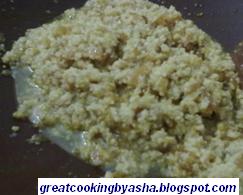Ingredients
For Dough
1 ½ cup whole wheat flour
¼ cup besan (Chickpea flour)
½ teaspoon salt
1 tablespoon ghee (clarified butter)
For Filling
½ cup besan (Chickpea flour)
1 cup Grated Jaggery
1 teaspoon roasted sesame seeds
½ teaspoon nutmeg powder
1 teaspoon milk
½ teaspoon ghee (clarified butter)
Method
Dough
Heat ½ teaspoon ghee in a Kadhai/Wok.
Add whole wheat flour to the kadhai and roast it for a while.
Empty it in a bowl and keep it aside.
In a same kadhai/wok heat ½ teaspoon ghee again.
Now add besan to it and roast it for a while.
Mix it to the whole wheat flour.
Add little salt to it and mix it well.
With the help of water, bind it to make a bit stiff dough.
Filling
In a Kadhai/Wok heat ½ teaspoon ghee.
Add besan and roast it for a while.
Remove from stove and cool it for about 10 minutes.
Mix grated jaggery, sesame seeds, and nutmeg powder to it. Mix it well.
Sprinkle a little milk over the mixture.
Bind the whole mixture together.
Preparation
Divide the dough in 6 - 8 parts and make small balls.
Divide the filling in equal number of parts and make small balls.
Roll the dough balls with the help of rolling pin into 4-5” diameter pancakes.
Place the filling in the centre of each pancake.
Now lift up the edges of the pancake inwards and towards the center, and press the edges down.
Now roll out the pancake into a 5-6” diameter circle with the help of a rolling pin.
Heat the non stick tava/frying pan.
Place the roti over tava.
Cook it over a slow flame (on a high or a medium flame, the filling may come out)
When one side gets cooked, turn it over so that the other side also gets cooked.
Apply ghee generously over it.
Serve while hot along with potato curry, any other Indian curry, Mix Vegetable, Undhiya (mixed vegetable in Gujrati style)










































